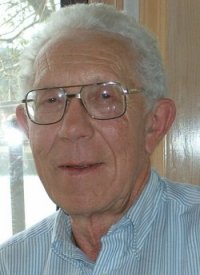| Henry was at home on his parents' farm when he heard about the attack on Pearl Harbor, outside Missoula, Montana. His uncle and his family were out visiting, and since the farm did not have electricity and only a battery operated radio, they listened to the reports about Pearl Harbor on his uncle's car radio. |
| Since Henry was in his early teens during the war, he did what many farm kids did whether they were in the Pend Oreille Valley or in Montana, he worked on his fathers farm. He helped with the haying and with the sugar beet crop throughout the war years. |
| THE RATIONING SYSTEM |
| It didn't have a great deal of affect upon us. In the first place we had a lot of stuff on the farm, vegetables and so forth, the root cellar was always full, mother canned a lot, and the problem with canning fruit was getting the sugar. Gasoline, being on the farm, we always had a better supply of gas than city people did. The rationing of shoes and other things didn't bother us. Everything had to last until it was totally worn out. Food was no problem, in fact we sold food from the farm, beets, carrots, milk, cream, butter, people would come out and buy them. |
| WHAT WAS THE MISSOULA AREA LIKE DURING THE WAR? |
| Missoula's experience during the war was quite similar to that of the Pend Oreille Valley, as they both were rural areas, impacted by a military presence, and the essential industries of agriculture and lumber. |
| Missoula was a rail junction point for the Milwaukee and Northern Pacific railroads. The Northern Pacific was steam powered and the Milwaukee was electrified lines and there was a branch line that went down the Bitterroot and what they hauled out of there in the Fall sugar beets and the rest of the year they hauled logs for the mills. |
| There were Mexican braceros that came in, and crews came for the growing process and the harvest. See there was a big sugar mill in Missoula, but we couldn't understand them, it was just something strange and out of the normal. |
| They were also training pilots in Missoula three or four miles away from our farm near the university, and what they had for training was the little yellow Piper Cubs. |
| They were flying all over the area practicing take-offs and landings and the like. There was also all sorts of scrap collecting going on because just about every farm had scrap iron laying around. |
| One final thing that made Missoula similar to the Pend Oreille Valley was the presence of enemy detainees or prisoners of war, as Henry expains: |
| Now Fort Missoula was not a military post during World War II, it was a detention center for primarily Japanese, Italian, German sailors who got caught in American ports when the war started. They were not in any way military and they were housed over there at Fort Missoula and which was only a mile, mile and a half away from our place and they would actually come out and scavenge on some of the farms, like our farm. We had a big orchard there which was no longer an effective orchard really in a sense but we had apples, they'd come out and pick apples for their own use and they would come out with a crew it was interesting because the crews that came out they were the Japanese and people thought my mother was foolish because they couldn't speak much English and she sure couldn't speak much Japanese and she basically would back out and let them come into the kitchen and cook their own meals, but we didn't have any problems with them. But many of the Italian and German prisoners became acquainted with American women from Missoula and there were a number of marriages that occurred after the war. |



